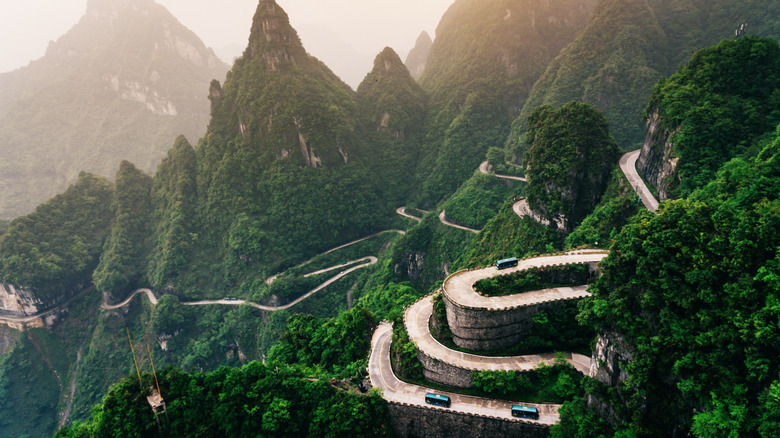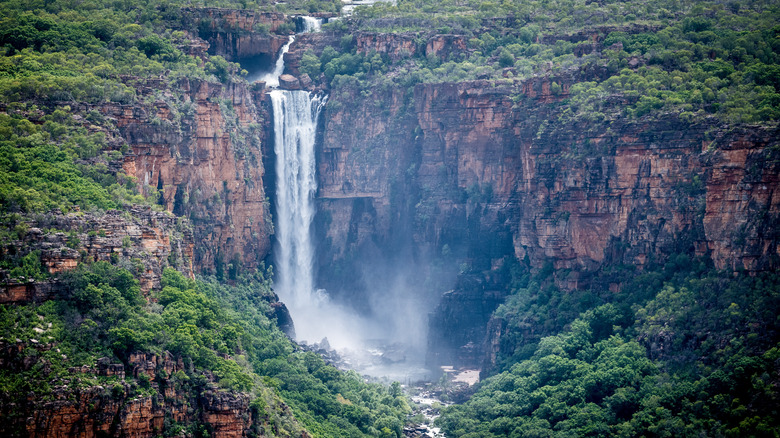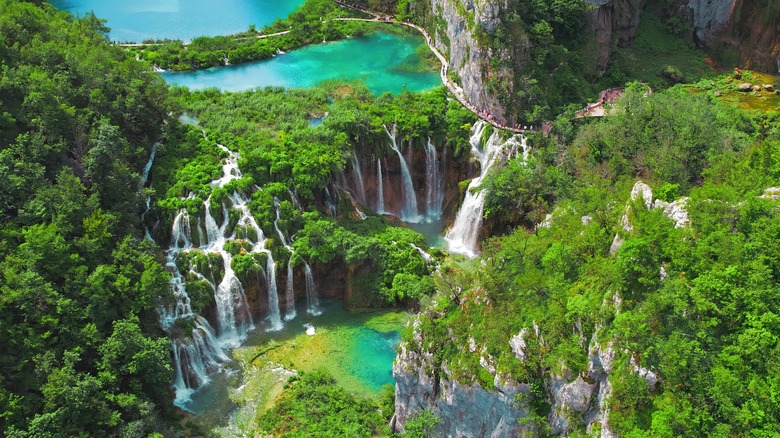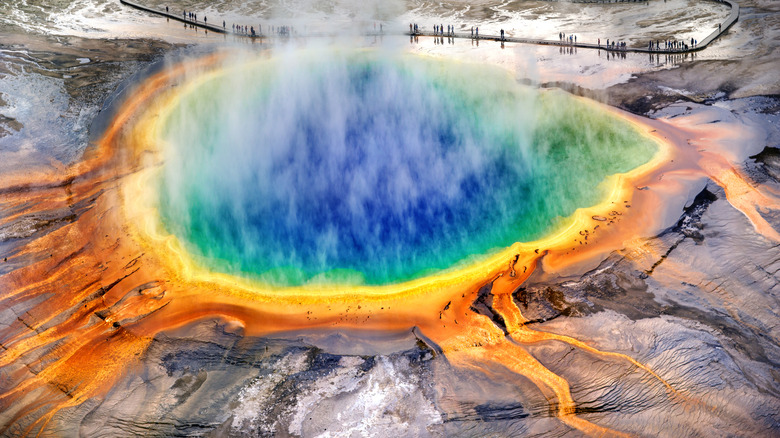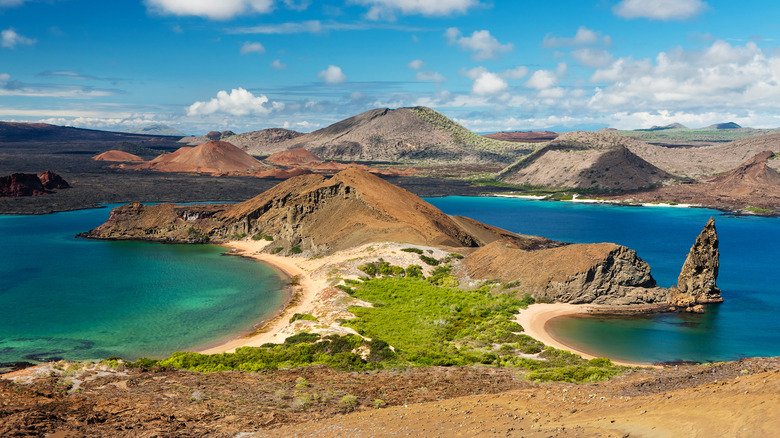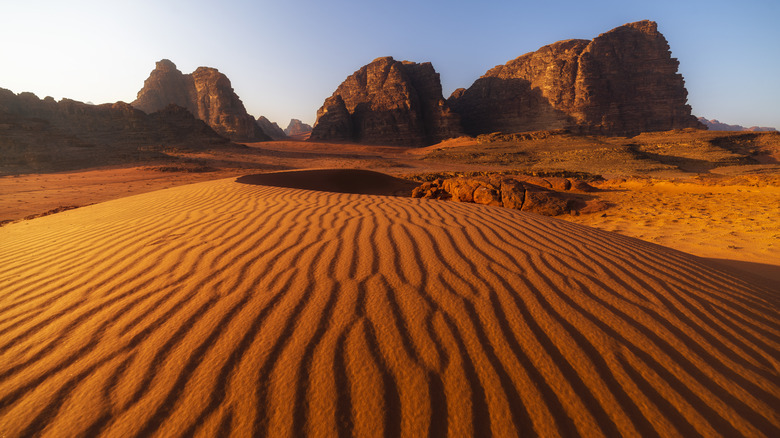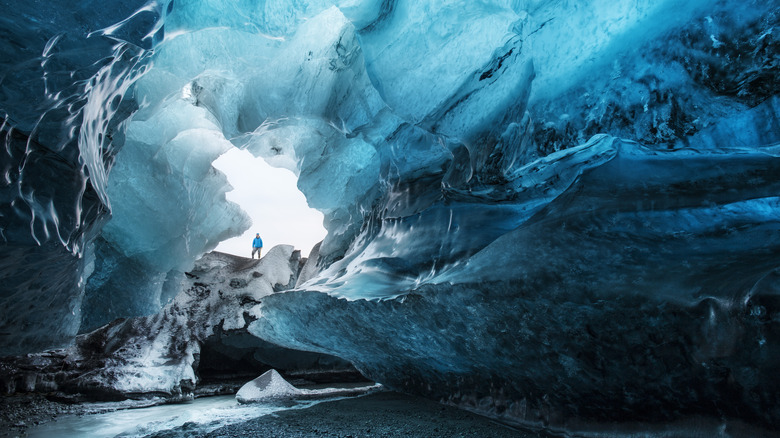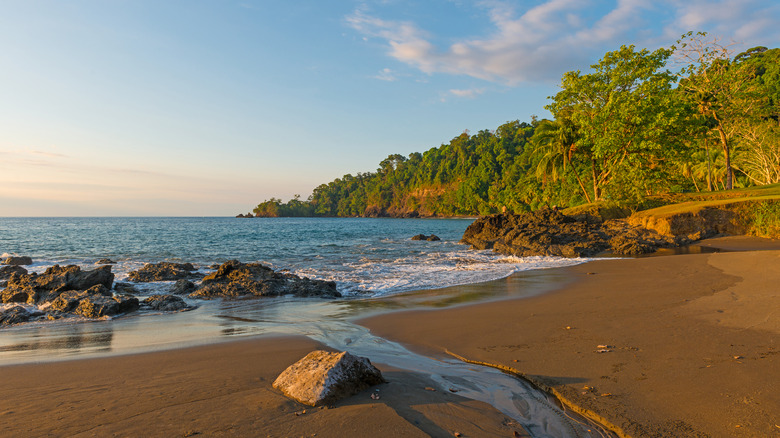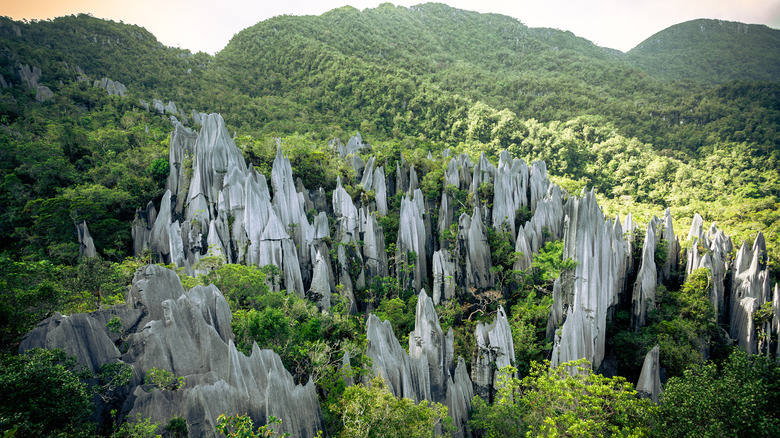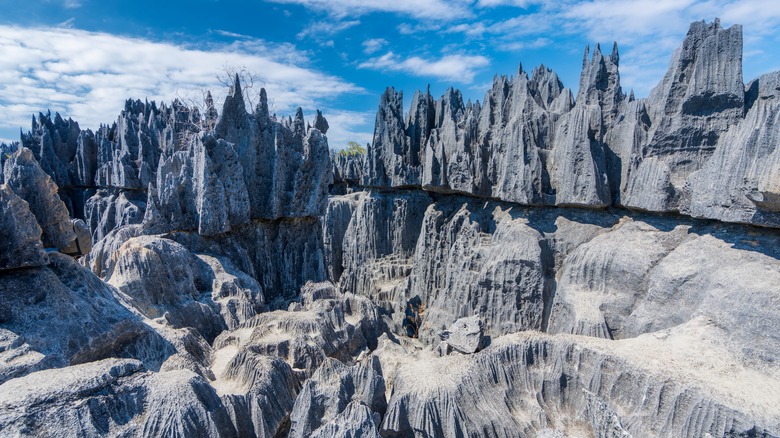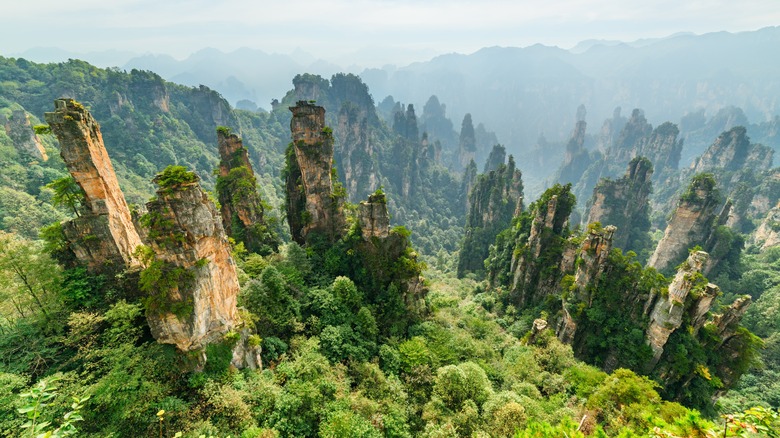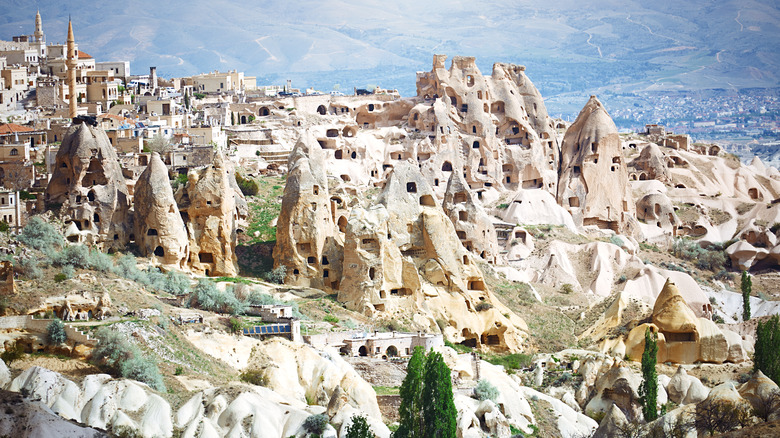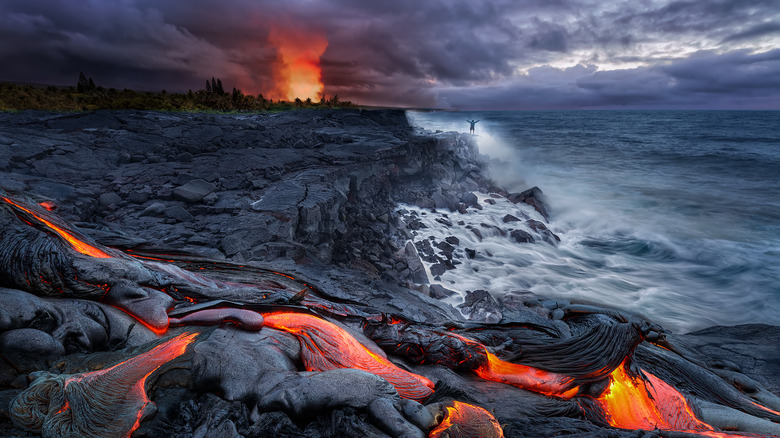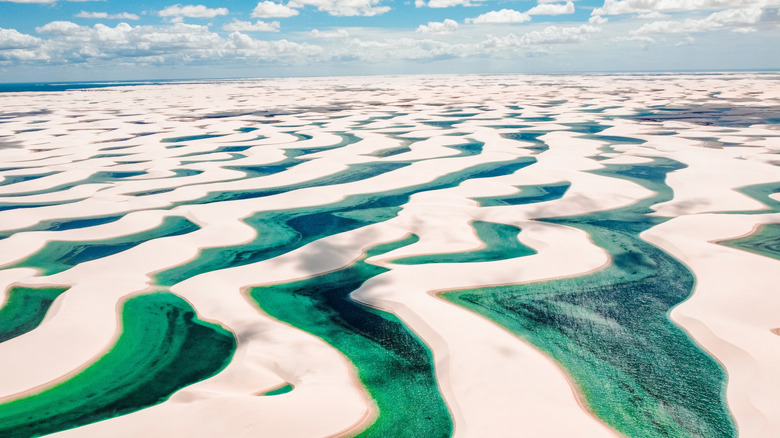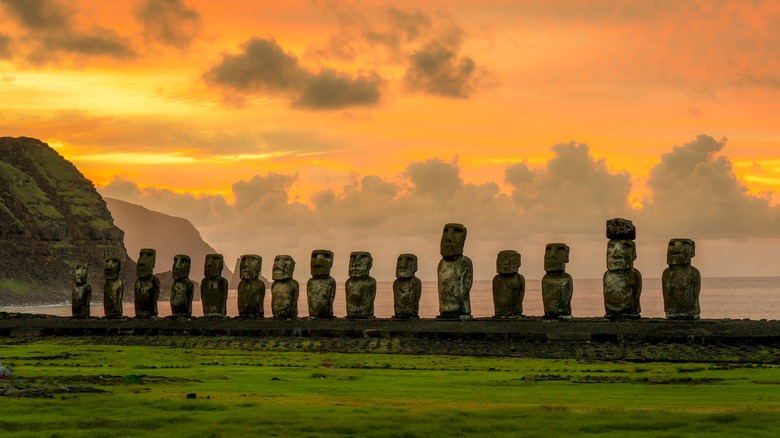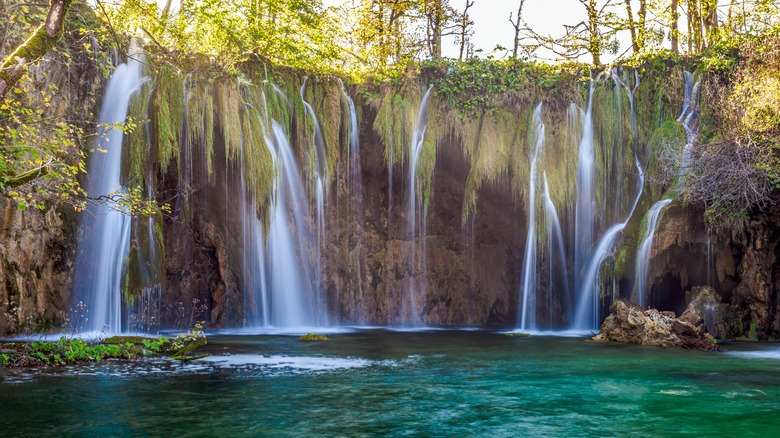The Most Unusual National Parks In The World, According To Travelers
When it comes to planning your next nature-filled vacation, you'll find no shortage of options. However, with over 6,000 national parks in nearly 100 countries across the world (all with their own plants, animals, topography, and activities to entice visitors), pinpointing the most worthwhile destinations can be a challenge. A beautiful challenge, but a challenge nonetheless.
From other-worldly limestone towers in China to hidden lagoons and sweeping dunes in Brazil, the following national parks stand out for their distinct features. You'll discover unique locales with remarkable qualities gathered from around the globe. These selections intentionally highlight a diverse array of natural wonders chosen to appeal to a variety of interests, whether you seek a jungle trek or a glacier-filled expedition.
Kakadu National Park, Australia
Unlike other nature-filled destinations that are just about the scenery, Kakadu National Park in Australia's Northern Territory gives visitors the opportunity to uncover details about over 65,000 years of Aboriginal culture and history. To learn about traditional lifestyles, mythology, and even a few local words, consider booking a spot on the Guluyambi Cultural Cruise led by the local Indigenous groups that co-run the park with Parks Australia. As part of the experience, you'll have the opportunity to spot some of the country's most exciting wildlife, like Kakadu's legendary crocodiles.
Beyond the cruise, you'll want at least three days to discover the many hikes, waterfalls, and other sights at the massive 7,722-square-mile Kakadu National Park. Consider making some space in your itinerary to visit Aboriginal rock art like Ubirr Rock, where you can see depictions of life from an estimated 1,500 years ago. Additionally, at Burrungkuy, also known as Nourlangie Rock, you'll find art that's a baffling 20,000 years old. For more unreal views during the wet season (November to April), don't skip Jim Jim Falls, the tallest waterfall in the Northern Territory.
Plitvice Lakes National Park, Croatia
Imagine a combination of Niagara Falls and the Grand Canyon and you'll get Croatia's stunning lakes region. Gem-toned lakes and waterfalls pack Plitvice Lakes National Park, all thanks to its many natural dams and clean and mineral-rich water. "Geologists are fascinated by Plitvice," Rick Steves shared on his website. "This fantasy world of lakes separated by natural limestone dams — constantly built up by deposits of calcium carbonate, even as they're eroded by the flow of water — is a perfect storm of unique geological features you'll rarely find elsewhere on earth."
Plitvice Lakes National Park is both an UNESCO World Natural Heritage List member as well as Croatia's first national park. Visitors can enjoy its 16 named lakes and over 90 cascades and waterfalls (including the biggest in the country), all surrounded by forest. You can use a number of different hiking trails to explore the area. Alternatively, opt for a boat tour that will lead you through the network of lakes. "This place is out of this world," wrote one Tripadvisor reviewer.
Yellowstone National Park, United States
Distinct, boiling geysers, hot springs, and canyons, characterize Yellowstone, which is often touted as the world's first national park. With a whopping 10,000+ hydrothermal sites and half the planet's active geysers, you'll want to give yourself a long weekend to explore the locale (at minimum). While many visitors just stop at the most popular sites and call it a day, the park offers so much beyond Old Faithful, Yellowstone's iconic geyser that erupts every 90 minutes or so.
One of Yellowstone National Park's most unique features is the giant, multi-colored Grand Prismatic Spring (at 370 feet in diameter it's longer than an American football field). The park also offers over 1,000 miles of trails. If you're up for a 6-mile round-trip hike, the 10,219 foot-tall Mt. Washburn provides panoramic views of the park. Looking for wildlife? Try to get to the park around sunrise, when you have the highest chance of spotting animals like bison, elk, moose, bighorn sheep, and wolves.
Galápagos National Park, Ecuador
The Galápagos Islands appear on many bucket lists for a reason. First unveiled to the rest of the world by Charles Darwin in his famous "On the Origin of Species," Galápagos, one of the most volcanically active places in the world, is home to one-of-a-kind wildlife like giant tortoises, tropical Galápagos penguins, marine iguanas, and multiple species of boobies. It also provides beach and scuba diving options if you'd rather explore underwater. Don't skip stargazing, either; due to its location along the equator, you can see constellations of the both the Northern and Southern Hemispheres simultaneously.
Getting to the Galápagos Islands isn't the easiest, thanks to their remote location about 600 miles off the coast of Ecuador. But the area has two separate airports, and you can opt to base yourself on one of the three inhabited islands, exploring the rest by boat for day trips. Alternatively, consider booking a cruise for even more ease and convenience.
Wadi Rum Protected Area, Jordan
Feel like you've escaped to another planet in Wadi Rum Protected Area, a remarkable desert locale in Jordan. The otherworldly destination served as the backdrop of movies like "Lawrence of Arabia," "The Martian," "Indiana Jones and the Last Crusade," and "Dune." Known as the "Valley of the Moon," with red sand dunes, rock formations, and canyons, Wadi Rum has scenery you can't see anywhere else.
In addition to its memorable environments, you can see fascinating rock carvings tied to the area's extensive history (some its first known residents were the Nabateans in the 4th century BCE) and stay in a traditional Bedouin campsite in Wadi Rum. "If you get the opportunity to visit Wadi Rum and stay overnight in one of the Bedouin tent camps – don't even think about it, just do it!," said one Tripadvisor reviewer. "Seeing the sun setting over the desert, running down sand dunes, riding a camel at sunrise, drinking tea with Bedouins, really seeing the sky at night, and witnessing the natural beauty of the desert – these are all memories that will stay with me forever."
Vatnajokull Glacier National Park, Iceland
Vatnajokull National Park, which makes up nearly 14% of Iceland, formed due to a combination of volcanic activity and glaciers, resulting in one of the world's most astonishing landscapes. Home to Europe's largest glacier, visitors can awe at mountains, black sand, glacier lagoons, and Europe's most powerful waterfall — not to mention animals like wild reindeer. The park also houses ten different volcanoes, eight of which are subglacial; two number among the country's most active.
Renting a car or campervan will be your best bet to tackling this massive park. Skaftafell, Jökulsárlón Glacier Lagoon, and Jökulsárgljúfur in the north are all easy to access and open year-round compared to some of its more remote highland areas, which only open during the summertime. "The ice caves are spectacular, and unlike anything I've ever seen," said one past visitor on Tripadvisor. "We ended up leaving as the sun was starting to set, which was a truly magical experience."
Corcovado National Park, Costa Rica
Corcovado National Park is known as one of the world's most biodiverse destinations and the "Amazon of Costa Rica." Located on the country's remote Osa Peninsula, the park features 13 major ecosystems; you can see everything from rainforest and cloud forest to jolillo palm forest, and mangrove swamps, plus coastal marine and beach habitats, just to name a few.
From secluded sand beaches and coconut palm trees to hidden waterfalls and abundant wildlife (including endangered species like tapirs, jaguars, and ocelots) Corcovado provides a diverse nature experience. New species are even continuously discovered there, including many that exist nowhere else in the world. "SO worth traveling so far!" said one Tripadvisor reviewer. "We saw wildlife we never imagined we could see!" You can only visit the park with a licensed tour guide, who can lead you through the various hiking trails and routes.
Gunung Mulu National Park, Borneo
Despite having three mountains, rainforests, waterfalls, and jungle streams, the most distinct and unusual element of Gunung Mulu National Park is what lies underneath the ground. One of the largest limestone cave systems in the world waits below the surface, offering up a unique geological history that spans over 1.5 million years. With karstic terrain composed of sinkholes, springs, and similar and substantial biodiversity, "not many places like this are left on the Earth," said one Tripadvisor reviewer.
Visitors need a guide to explore the caves, where possible experiences include swimming through underground rivers, climbing over boulders, and witnessing a bat exodus. There's lots to explore above ground as well, such as crossing Mulu Canopy Skywalk, the world's longest tree-based canopy walk, and participating in its three adventure treks, like the challenging Pinnacle Summit Trek that leads to Mulu's iconic and downright unusual limestone spikes. The latter takes three days and two nights to complete, providing plenty of opportunities to take in the local ecosystems.
Tsingy De Bemaraha National Park, Madagascar
"Tsingy" means "walking on tiptoes" in the local Malagasy language, and that's exactly what it feels like to venture through Tsingy de Bemaraha's jagged stone forest. The one-of-a-kind landscapes of this park in western Madagascar resulted from millions of years of erosion and weathering processes. With its limestone cathedrals and knife-like structures, it doesn't seem like the most hospitable environment. Surprisingly, there's lots of wildlife in the area, including endemic species like the Tsingy wood rail and the Madagascar fish eagle.
Plan to visit between June and November, the only time that the Great Tsingy, one of the park's main limestone plateaus, is open. "This is truly one of the most spectacular views I've experienced and suddenly made it worth the agonizing 13-hour bus trip from Antananarivo to Morondava followed by another day by jeep to get there," shared travel blogger Linn Haglund of Brainy Backpackers.
Zhangjiajie National Forest Park, China
Zhangjiajie, a national park in the Hunan Province of China, has some of the most unique scenery on the planet. Composed of massive stone pillars surrounded by subtropical forests, "Zhangjiajie National Forest Park stands as an extraordinary natural wonder, offering visitors an otherworldly landscape that seems straight out of a fantasy film," as detailed by one Tripadvisor reviewer. In fact, the park's mountains helped inspire James Cameron's "Avatar."
Zhangjiajie National Forest Park's hiking trails gift visitors the chance to see wildlife like macaques, a type of monkey, and civets, a cat-like mammal. Other experiences include riding one of the world's tallest outdoor elevators and crossing the glass skywalks in the Tianmen Mountain Scenic Area. Culture seekers should also consider stopping by the traditional villages around the park for a chance to learn about the Tujia ethnic group from the western Hunan and Hubei provinces.
Death Valley National Park, United States
As the hottest, driest, and lowest-elevation national park in the United States, you can bet that extraordinary landscapes fill Death Valley. From the pastel-colored hillsides of Artists Palette to the cracked salt flats of Badwater Basin, visitors can revel in Mars-like landscapes throughout this section of California. "This otherworldly landscape offers breathtaking scenery, unique geological formations, and some of the most surreal desert views in country," confirmed a Google reviewer.
For some of the best hikes, head to the Golden Canyon, which has three main trails and other small paths that weave through gold- and pink-toned badlands and canyons. Other notable sites include the popular Zabriskie Point, a beautiful overlook, and Mesquite Flat Sand Dunes, where some of the dunes reach as high as 100 feet. Just don't plan your trip for the summer — with temperatures typically climbing to 120 degrees and above, you're much better off visiting during the rest of the year.
Göreme National Park, Turkey
Göreme National Park merges rock-carved churches and homes with an immense history dating back to the 4th century. From exploring the underground cities of Kaymakli and Derinkuyu to the Byzantine-era Selime Monastery, this locale packs in lots of features for visitors to peruse. To take in frescoes from the 10th and 11th centuries, add the Göreme Open Air Museum, an UNESCO World Heritage Site which houses some of the region's most important churches, to your itinerary.
"It's so different from any other place you've ever been that you'll be surprised at every turn: enclaves, caves, churches, and more," said one Tripadvisor reviewer in Spanish (via Google Translate). "They ... are unparalleled anywhere else in the world." For a look at Göreme's volcanic terrain from above, book a spot on one of the world's best hot air balloon rides.
Hawaiʻi Volcanoes National Park, United States
Without a doubt, Hawaii Volcanoes National Park is one of the most exciting things to do on Hawaii's Big Island. Within this park, you can see two of the island's volcanoes. At Kīlauea, one of the world's most active volcanoes, you can often observe lava flowing into the ocean or in its crater, while Maunaloa has the distinction of being the world's largest active subaerial volcano.
From peeking at lava tubes to checking out the over 100 miles of hiking trails, Hawaii Volcanoes National Park is full of nature sites. While there, consider stopping by the steamy cracks of Sulphur Banks (Haʻakulamanu) and driving along Mauna Loa Road to a scenic lookout. This park is also rich in culture and history, which can be experienced at a number of different points. The Puʻuloa Petroglyphs require a moderate 1.4-mile round trip hike to reach, but you'll be rewarded with the discovery of over 23,000 petroglyphs depicting Native Hawaiian life and culture.
Lençóis Maranhenses National Park, Brazil
Brazil is full of dreamy destinations and stunning beaches, but one of its most other-worldly spots is Lençóis Maranhenses National Park. With jade-colored freshwater lagoons rippling across bright-white sand dunes, it's hard to believe that this park in northeastern Brazil is real. "Without a doubt, it's my favorite 'beach' destination in Brazil, and truly one of the most unique places in the world," said travel blogger Danae Explore.
Aim to visit between May and September when the lagoons have the highest water levels, making them more ideal for swimming. You can also experience the area through hiking, taking a boat trip, or going on a 4x4 tour. You can even sand board on the dunes. Consider basing yourself in Barreirinhas, the most developed nearby town, or Santo Amaro or Atins on the other side of the park for a quieter, more rustic stay.
Rapa Nui National Park, Chile
Part of what makes Chile's Rapa Nui National Park so unique is its remote location, 2,000 miles off of South America's coastline and 1,100 miles from its closest Polynesian neighbor. Additionally, much still remains unclear about Rapa Nui, also known as Easter Island. Questions such as where its original residents came from, exactly when they arrived, and what brought them to Rapa Nui all lack definitive answers.
Today, visitors are largely drawn by Rapa Nui's moai statues, which can be found throughout the park. Highlights include Ahu Tongariki, where you can see an array of 15 statues. Meanwhile, ꞌŌroŋo Village offers stone slab houses, petroglyphs, ocean views. You may alos wish to pencil in some time at the the Tāhai Ceremonial Center to watch the sunset.
Current regulations require a local guide to access the park. "Being able to hear the island's history from someone whose family lived it is invaluable," wrote a Redditor in r/solotravel. "Every guide has unique personal anecdotes that make you cling to every word. Listen to them!"
Methodology
The highlighted national parks encompass a variety of landscapes and offerings, from deserts and jungles to history-filled destinations. More importantly, they each have distinct features (or combinations of features) you won't find elsewhere in the world. Consulting reviews, Reddit threads, tourism sites, and travel blogs further ensured that each spot is worth visiting and the accuracy of the information.
